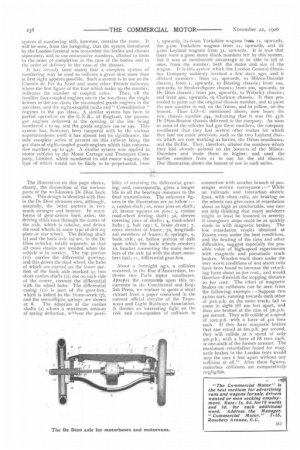The illustration on this page shows, clearly, the disposition of
Page 8

If you've noticed an error in this article please click here to report it so we can fix it.
the various parts of the well-known De Dion back axle. This design is identical with that in the De Dion pleasure cars, although, naturally, the latter pattern is very much stronger and heavier. In many forms of gear-driven back axles, the driving shaft runs through the centre of the axle, which is tubular, and drives the road wheels by some type of driviieplate or star wheel. The driving shaft (2) and the back axle (9) are, in the De Dion vehicles, totally separate, so that all cross strains are avoided when the vehicle is in service. The top portion (XI) carries the differential gearing, and this drives the rbad wheel, the hubs of which are carried on the lower portion of the back axle marked 9 ; two short cardan shafts (2), one on each side of the centre, connect the differential with the wheel hubs. The differential casing (u) is part of the gear-box, which is bolted to the frame-work (7), and the semi-elliptic springs are shown at 8. The adoption of the cardan shafts (2) allows a maximum amount of spring deflection, wio-lout the possi bility of straining the differential gearing, and, consequently, gives a longer life to all the bearings common to the final transmission. The reference figures in the illustration are as follow :2, cardan shaft; 2a, cross pins on shalt; 2b, bronze squares on pins; 3, cardan road-wheel driving shaft; 3a, sleeves covering jaws of shafts; 4, road-wheel hubs; 5, hub cap; 6, brake drum; 7, cross member of frame; 7a, longitudinal members of frame; 8, springs; 9, back axle; qa, hollow portion of axle upon which the hack wheels revolve; to, bracket connecting the main members of the axle (9) with the short members (9a); ii, differential gear-box.
About a fortnight ago, a collision occurred, in the Rue d'Amsterdam, between two Paris motor omnibuses. Apropos the comments. upon this occurrence in the Continental and English Press, we venture to quote a short extract front a paper contained in the current official circular of the Tramways and Light Railways Association. It throws an interesting light on the risk and consequence of collision in connection with another branch of passenger service conveyance :—" While on railroads and interurban electric lines, with clean rails, air braking on the wheels can give rates of retardation about as high as comfortable, one cannot help thinking that many accidents might at least be lessened in severity if emergency stops could be as quickly made as with magnetic brakes. The low retardation results obtained at Zossen even under the best conditions, and the heating of the tires and other difficulties, suggest especially the possible value of high-speed experiments with magnetic and pneumatic track brakes. Wooden track shoes under the very worst conditions of wet street rails have been found to increase the retarding force about 20 per cent., and would therefore diminish the stopping distance 20 per cent. The ettect of magnetic brakes on collisions can be seen from the following example :—Suppose two 25-ton cars, running towards each other at 3ont.p.h. on the same track, fail to come in sight till 200 feet apart, and then are braked at the rate of 3rn.p.h. per second. They will collide at a speed of 22m.p.h. with a force of 410 tons each. If they have magnetic brakes that can retard at 6m.p.h. per second, they will collide at a speed of only 9m.p.b., with a force of 68 tons each, or one-sixth of the former amount. The maximum retardation found for magnetic brakes in the London tests would stop the cars 6 feet apart without any collision at all." After these figures, motorbus collisions are comparatively


































